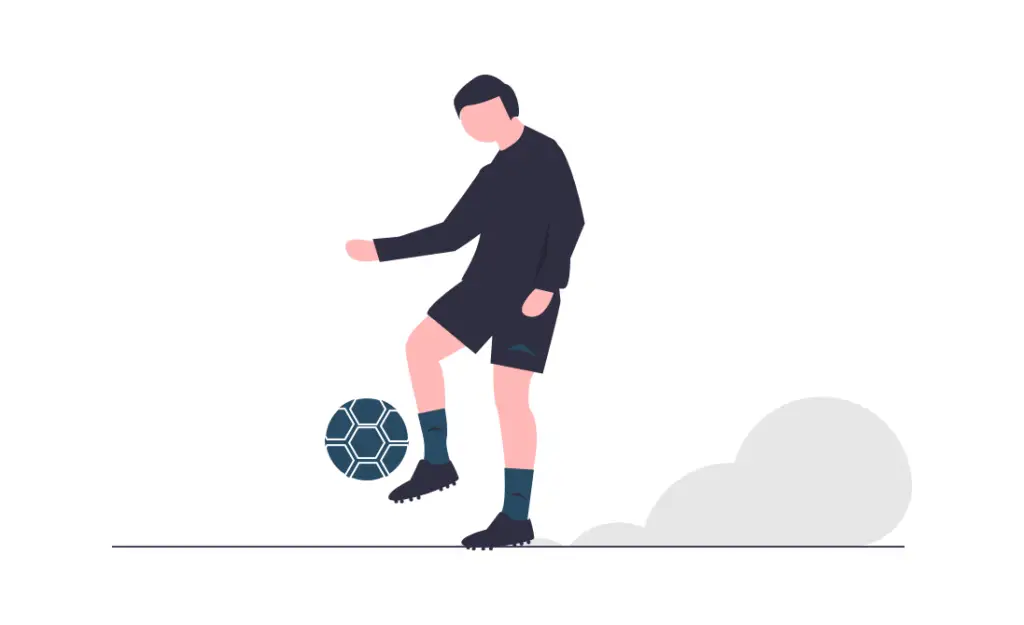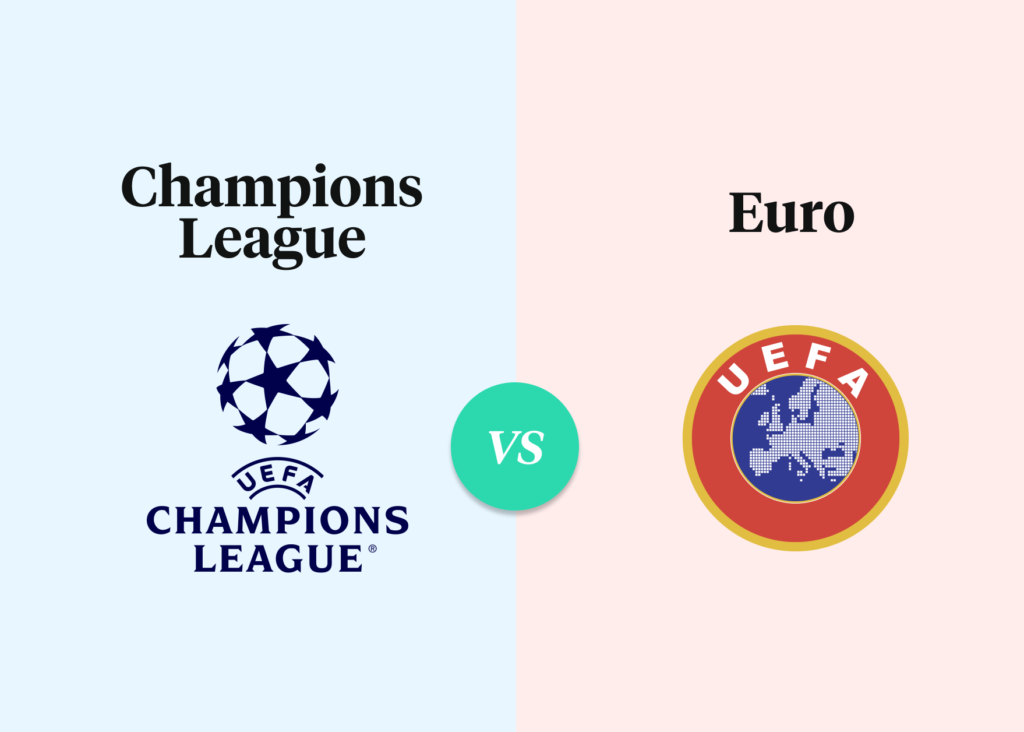Last updated on June 25th, 2022
If you’re a fan of European football, you may have watched your side compete in the UEFA Champions League or seen your nation take part in the Euros tournament.
However, what’s the difference between these competitions, and which one has more value?
Here’s what you need to know:
Contents
- 1 The difference between Champions League and Euros
- 2 Number of teams involved
- 3 Origin of teams
- 4 Types of teams
- 5 Frequency and duration of the competition
- 6 Format of the competition
- 7 Number of matches
- 8 Squad Size
- 9 Qualification for the competition
- 10 Rewards for winning the competition
- 11 Verdict
- 12 Conclusion
The difference between Champions League and Euros
The Champions League is an annual premier competition for clubs that originate from UEFA countries, while the Euros is an intracontinental tournament for UEFA national teams that is held every 4 years.
Here’s an in-depth comparison between the two competitions:
Number of teams involved
The Champions League is contested by 32 teams from around Europe. The teams are split into 8 groups of 4 teams.
Meanwhile, the Euros split 24 teams into 6 groups of 4 teams.
The Euros was previously contested by just 16 teams, but it was extended to 24 teams ahead of the 2016 edition.
As such, there will be a greater variety of teams in the Champions League compared to the Euros.
This only measures teams participating in the major tournament, there will be several teams that were involved in the qualifying rounds which do not make the group stages.
Origin of teams
All teams and nations that take part in the Champions League and Euros must be members of UEFA.
UEFA is the governing body for European football which means sides outside Europe cant take part and will instead participate in their continental competitions.
Types of teams
The UEFA Champions League is contested by the best club sides in Europe. This involves the best-performing teams in countries across the continent.
Meanwhile, the Euros is exclusively for national sides.
This makes a difference because football clubs can choose the players they buy and sell. As such, it is easier to strengthen the personnel of a football team and build a strong side for each season.
However, this is a bit different for national teams. Players are obligated to represent their own country and while some players may switch national teams, they must meet certain criteria first before doing so.
It is common for countries to have one or two standout players, while the rest of the team may not be of that same standard. An example of this is Austria’s David Alaba.
Other countries like Italy and Spain have really strong squads with top-level players throughout the team.
Frequency and duration of the competition
The Champions League is an annual competition. The group stage usually begins in September with the final played in late May or early June, a span of 8 months.
The Euros is played every 4 years and played over a month from June to July in the summer.
The Covid 19 pandemic has affected recent editions of both competitions with the 2020 UCL final played in August and EURO 2020 being played in the summer of 2021.
Format of the competition
Both the Champions League and the Euros contain a group stage and a knockout phase.
For the Champions League, the 32 teams are split into 8 groups of 4 teams. The teams face off in the home and away ties and the top two teams from each group advance into the Round of 16.
Meanwhile, the third-placed team for each group will qualify for the UEFA Europa League.
The format of the Euros is a bit different. Every team in the group faces each other only once, and the two top teams qualify for the Round of 16.
The third-place teams in all 6 groups are placed in a table, and the 4 best third-placed sides qualify for the last 16, along with the other 12 automatic qualifiers.
As a result of this, 16 of the 24 teams that participate in the Euros play in the knockout rounds, which is an unusual format for a football competition.
If you’re wondering what happens if the top two teams finish on the same points, you can check out this article for more information.
Presence of third-place match
The Champions League does not host third-place matches, and the losers of both semi-finals will exit the competition.
Unlike the World Cup and most other international tournaments, the Euros also don’t use third-place matches. However, this wasn’t always the case as third-place matches were only removed in 1980.
2 legged ties in the knockouts
Every Champions League knockout round except the final is played in a home and away format.
For the Euros, all knockout games are played as single matches, with extra time and penalties in the case of a tie.
Away goal rules
UEFA abolished the away goal rule in June 2021 as part of reforms to the competition’s format.
The Euros are one-legged so no away goals are involved.
Number of matches
Assuming your team can reach the final of the Champions League from the group stage, they would have played 13 games all tournament.
For the Euros, this number comes down to 7 games, because:
- You only face your group stage opponents once instead of twice as seen in the Champions League
- The knockout round employs a single-legged format as opposed to home and away
Double-legged rounds in the CL ensure that there is no ‘unfair’ advantage to any side, as both teams have the benefit of playing in front of their fans.
For the Euros, all knockout games are played in single legs.
| Round | Champions League | Euros |
|---|---|---|
| Group Stage | 6 | 3 |
| Round of 16 | 2 | 1 |
| Quarter-Finals | 2 | 1 |
| Semi-Finals | 2 | 1 |
| Final | 1 | 1 |
Squad Size
For the Champions League, there are 2 lists that a team can register for the team’s squad.
The first list (List A) has a maximum of 25 players, where 8 of them have to be homegrown players. Meanwhile, the second list (List B) consists of players who are born on or after 1 Jan 1995 as well as other requirements.
There can be an unlimited number of players who are registered on List B.
For the Euros, a squad list of 23 players is allowed for each team. However, the squad size was increased to 26 for the 2020 Euros because of the COVID-19 pandemic.
Qualification for the competition
Qualifying for the Champions League is done through the league positions of a team in their domestic league.
UEFA associations are all given at least 1 spot for the Champions League with some of the top leagues having as many as four slots allocated for them. Here are some leagues in Europe and their allocation for the Champions League:
| League | Number of CL Spots |
|---|---|
| English Premier League | 4 |
| Spanish La Liga | 4 |
| German Bundesliga | 4 |
| French Ligue 1 | 3 |
| Italian Serie A | 4 |
| Scottish Premiership | 2 |
| Portuguese Primeira Liga | 2 |
The countries with 4 slots are the ones with the highest UEFA coefficients. This means that clubs from these countries have performed the best in UEFA competitions in the last 5 years.
Moreover, the winners of the previous season’s UEFA Europa League and UEFA Champions League competitions automatically qualify for the next season’s Champions League.
Chelsea FC finished 6th in the Premier League in 2012 but qualified for the 2013 Champions League by winning the final in 2012.
For the Euros, there will be a qualification tournament for all of UEFA’s association countries. Countries are drawn into 10 groups, and the top two teams from each group qualify automatically for the Euros tournament.
Meanwhile, the top 16 teams (based on the performance of the UEFA Nations League) who did not already qualify for the Euros will play in the qualifying play-offs.
This made it important to perform well in the UEFA Nations League if your country is looking to enter the Euros!
The host nation automatically qualifies for the Euros.
Rewards for winning the competition
When your country wins the Euros, it’s one of the greatest achievements a player can make with their country as it makes them the best nation in Europe for the next 4 years.
Winning the Champions League is also an incredible achievement and is the pinnacle of club football in Europe. The winners of the competition gain automatic qualification for the next season’s tournament, and also to the UEFA Super Cup where they will face the Europa League champions.
You can find out more about the differences between club football and international football here.
Verdict
Here is a summary of the comparison between these two competitions:
| Champions League | Euros | |
|---|---|---|
| Number of Teams | 32 | 24 |
| Origin of Teams | Europe | Europe |
| Types of Teams | Club teams | National Teams |
| Qualification | Best teams in each league + CL AND EL winners | Euro Qualifiers (top 2 teams from each group) Euro qualifying playoffs (best 16 teams b ased on UEFA Nations League) |
| Frequency of Competition | Annually | Every 4 years |
| Duration of Competition | 8 months | 1 month |
| Format of Competition | Group stage + Knockout round (RO16) | Group stage + Knockout round (RO16) |
| Number of Matches | Up to 13 | Up to 7 |
| Third Place Match | No | No |
| Squad Size | 25 (A List) Unlimited (B List) | 23 |
| Automatic Qualification | Winners of the previous season’s CL and EL | Only for hosts |
| Rewards for Winning Competition | Qualification for next season’s tournament UEFA Super Cup | Champions of Europe |
Conclusion
Both the Champions League and the Euros are prestigious competitions. However, the Champions League is a club competition while the Euros is contested by national teams.
The question of which tournament is more prestigious may vary between players depending on what they value more between club success and winning with their country.
Subscribe to Telegram and Twitter to get the latest updates!

Are you passionate about football and want to earn some side income?

